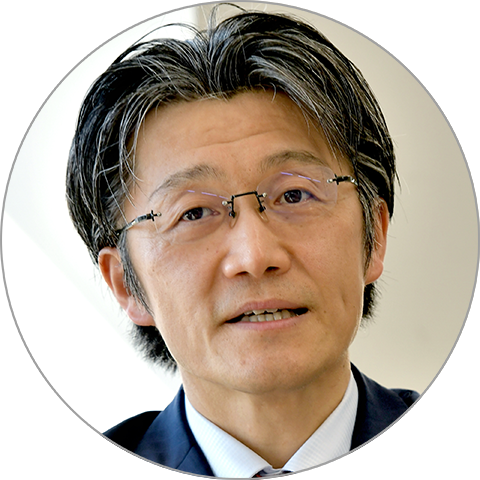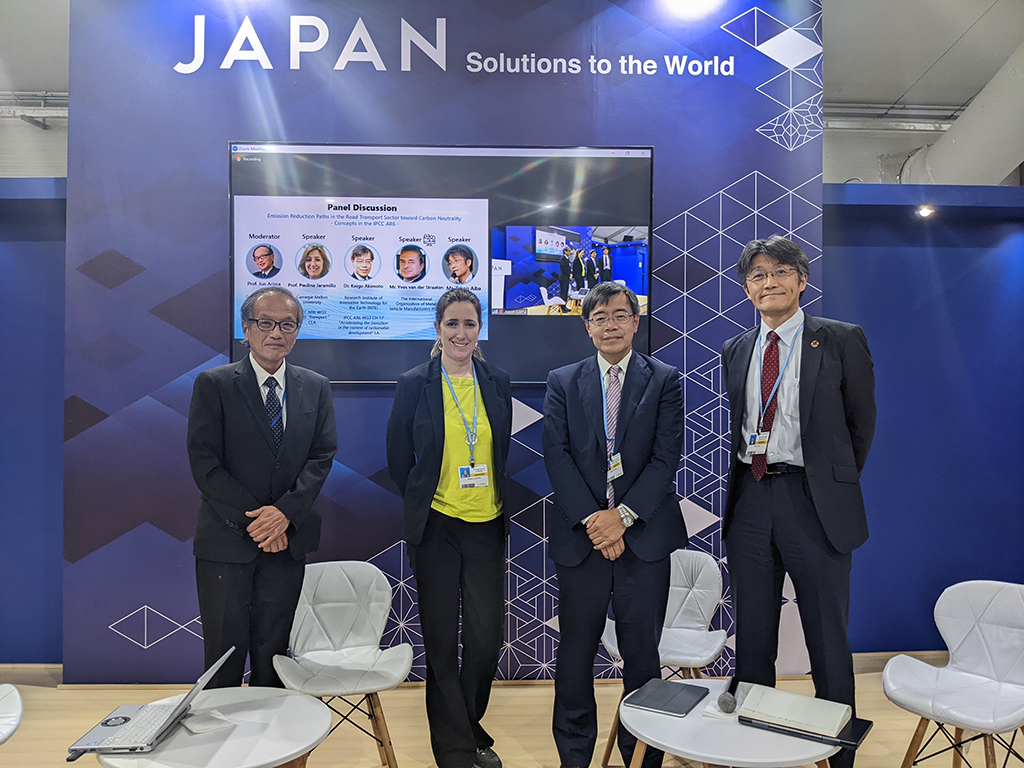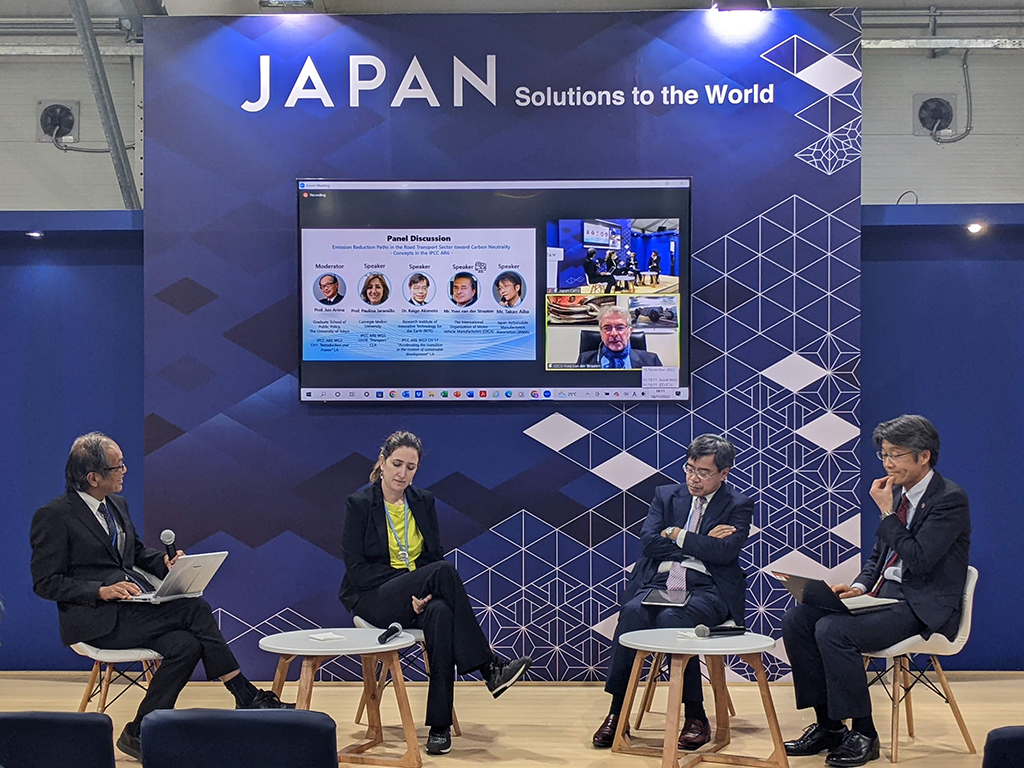JAMA's side event at COP27 (Nov. 2022)
1. Seminar abstract:
November, 18 2022, at the COP27 venue in Sharm El Sheikh, Egypt. A side event titled “Emission Reduction Paths in the Road Transport Sector toward Carbon Neutrality -Concepts in the IPCC AR6-” was held at the Japan Pavilion, hosted by Japan Automobile Manufacturers Association.
Inviting the leading authors of the IPCC, the world`s authoritative on scientific knowledge and the secretariat of OICA, the representative of global automobile manufacturers associations such as European, US automobile associations as a speaker/panelist, we discussed emission reduction paths in the road transport sector toward Carbon Neutrality.
【Speakers】
- CLA of IPCC AR6 WG3 Chapter 10 “Transport”
Paulina Jaramillo Carnegie Mellon University, Professor - LA of IPCC AR6 WG3 Chapter 1 “Introduction and Framing”
Jun Arima(Graduate School of Public Policy, The University of Tokyo) Project Professor * Moderator - LA of IPCC AR6 WG3 Chapter 17 “Accelerating the transition in the context of sustainable development”
Keigo Akimoto(Research Institute of Innovative Technology for the Earth (RITE)) Group Leader/Chief Researcher, LA of IPCC AR6 WG3 Chapter 17 - Yves van der Straaten(The International Organization of Motor Vehicle Manufacturers (OICA)) Director General
- Takao Aiba(Japan Automobile Manufacturers Association (JAMA)) Chairperson of the International Climate Change Policy Expert Group
2. Summary of presentations from each speaker:

- Demand-side options and low-GHG emissions technologies can reduce transport sector emissions in developed countries and limit emissions growth in developing countries.
- Electric vehicles powered by low-emissions electricity offer the largest decarbonization potential for land-based transport, on a life cycle basis.
- EV technology is at a high technology readiness, costs are decreasing, and concerns are increasingly addressable.
- The transport sector is unlikely to reach net zero CO2 emission so carbon dioxide removal is likely needed to counterbalance residual CO2 emission from the sector.

- Electrification is a key measure for achieving carbon neutrality. Shifts from ICE to EV are also important.
- On the other hand, CDR such as DACCS and BECCS will contribute to offsetting the residual emissions of fossil fuels also in the transport sector. In addition, synthetic fuels based on renewables will play a certain role to achieve carbon neutrality in transport sector.
- The assessments of total energy systems in energy supply, transport, and CDR are important for cost-effective emission reduction measures. BEV-only will not be a dominant measure in the road transport sector. Several kinds of road transport measures have potential cost-effective reductions in different time points, different countries, and different perspectives in technologies.
- All of the options in the road transportation sector could have not only synergy effects on SDGs but also trade-off effects, depending on countries, scales of deployments, different time points, etc.
- Lower costs of emissions reduction with consideration of full spectrum options will be able to increase SDG1 (no poverty) and 2 (zero-hunger), for example, while the IPCC AR6 had not assessed sufficiently, and therefore, the balanced emissions reduction response measures toward carbon neutrality will be important also in road transport sector.

- Collaboration to identify the most suitable approach(es) for all individual nations, considering: Economic realities, Geographic realities, Cultural realities.
- Electrification will play a leading role in this transition; but it is probably not the most appropriate single technology for all nations.
- Technology neutral approach to enable all nations to implement practical, sustainable, alternative or complementary measures

- JAMA member companies will make maximum efforts towards carbon neutrality by 2050.
- Our goal is carbon neutrality. It is essential to understand the issue correctly.
- it is the consumer who chooses the vehicles. We believe that it is important to maintain diverse choices for diverse customers and to expand choices further based on technological neutrality.
- Region by region, a desirable pathway toward carbon neutrality is different as energy and relevant situations are divergent.
- Based on the quantitative scenario analysis, JAMA believe that there is potential not only for 100% BEVs, but also for a wide variety of electrified vehicles including HEVs and PHEVs and the use of carbon-neutral fuel (CNF) for global CO2 emissions reduction in road transport to be in line with the IPCC’s 2050 1.5℃ climate scenarios.
- In such cases have its own challenges, and the automotive industry needs to work together with all stakeholders to solve these challenges, such as increasing renewable energy, developing charging and hydrogen refilling.

Prof. Arima
As summary of session:
- It is important to consider not only cost but also utility and convenience for consumers.
- EVs are definitely promising option, however not the single solution.
- Suitable option depends on each country and its situation. In other words, a technology neutral approach is logical, pragmatic approach for addressing climate change problem.
- Let`s see the process from now to 2030 and beyond.
- Offset technologies such as CDRs are also needed, as the transport sector may not be able to achieve complete carbon neutrality on its own.
Event Archive
3. Session Summary
Through the session, we demonstrated following messages to the audience:
- BEVs are one of the key option toward 2050 Carbon Neutrality.
- However, in the different circumstances in individual countries and regions, multiple pathways followed by technology neutral philosophy is the logical and practical approach.


AR6 |
Sixth Assessment Report |
|---|---|
BAU |
Business As Usual |
BECCS |
Bioenergy with Carbon Capture and Storage |
BEV |
Battery Electric Vehicle |
CLA |
Coordinating Lead Author |
CDR |
Carbon Dioxide Removal |
CN |
Carbon Neutral |
DACCS |
Direct Air Carbon dioxide Capture and Storage |
GHG |
Greenhouse Gas |
JAMA |
Japan Automobile Manufacturers Association |
ICEV |
Internal Combustion Engine Vehicle |
IEA |
International Energy Agency |
IPCC |
Intergovernmental Panel on Climate Change |
LA |
Lead Author |
NZE |
Net Zero Emissions by 2050 |
OICA |
Organisation Internationale des Constructeurs d'Automobiles |
SDGs |
Sustainable Development Goals |
WG3 |
Working Group 3 |

